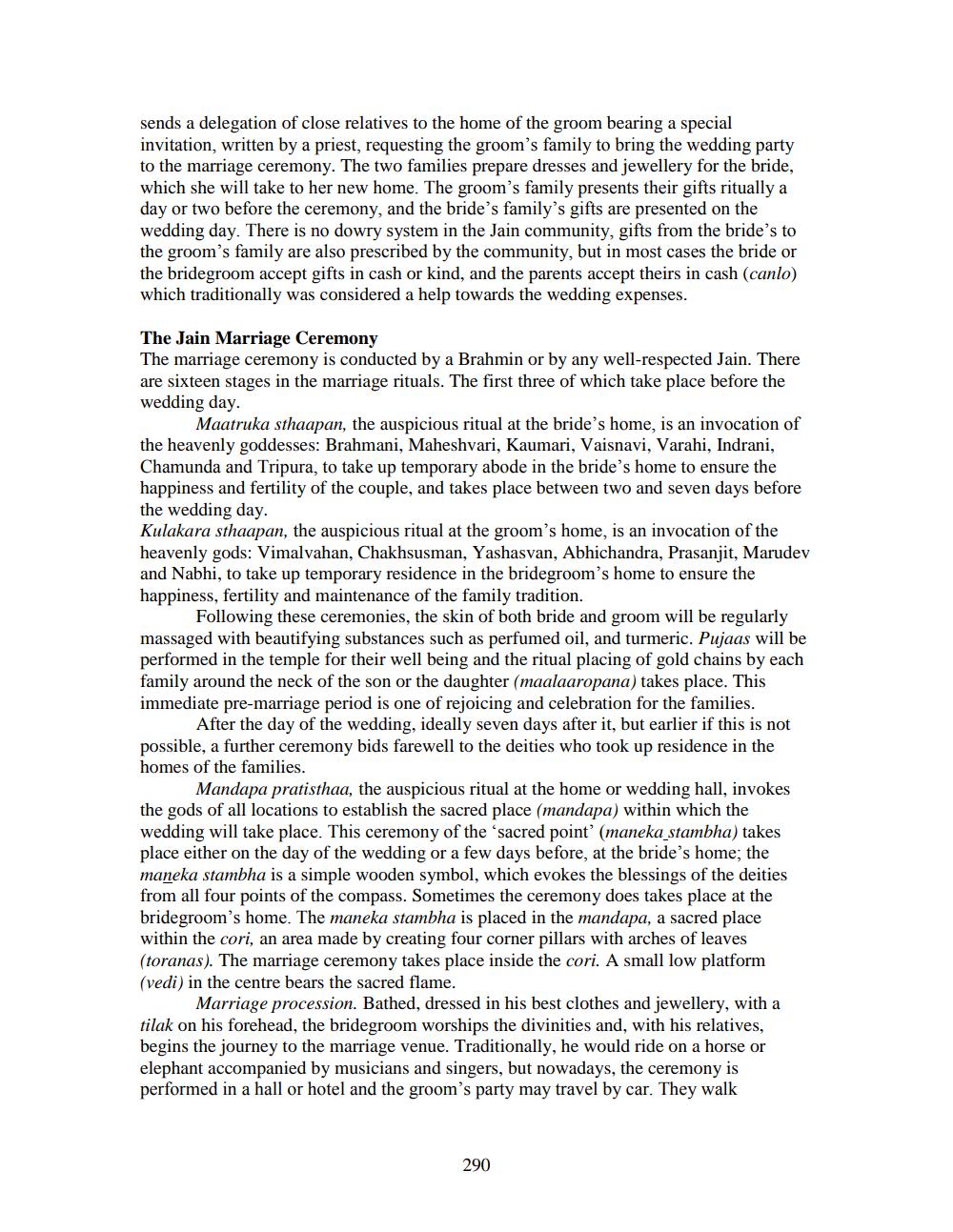________________
sends a delegation of close relatives to the home of the groom bearing a special invitation, written by a priest, requesting the groom's family to bring the wedding party to the marriage ceremony. The two families prepare dresses and jewellery for the bride, which she will take to her new home. The groom's family presents their gifts ritually a day or two before the ceremony, and the bride's family's gifts are presented on the wedding day. There is no dowry system in the Jain community, gifts from the bride's to the groom's family are also prescribed by the community, but in most cases the bride or the bridegroom accept gifts in cash or kind, and the parents accept theirs in cash (canlo) which traditionally was considered a help towards the wedding expenses.
The Jain Marriage Ceremony The marriage ceremony is conducted by a Brahmin or by any well-respected Jain. There are sixteen stages in the marriage rituals. The first three of which take place before the wedding day.
Maatruka sthaapan, the auspicious ritual at the bride's home, is an invocation of the heavenly goddesses: Brahmani, Maheshvari, Kaumari, Vaisnavi, Varahi, Indrani, Chamunda and Tripura, to take up temporary abode in the bride's home to ensure the happiness and fertility of the couple, and takes place between two and seven days before the wedding day. Kulakara sthaapan, the auspicious ritual at the groom's home, is an invocation of the heavenly gods: Vimalvahan, Chakhsusman, Yashasvan, Abhichandra, Prasanjit, Marudev and Nabhi, to take up temporary residence in the bridegroom's home to ensure the happiness, fertility and maintenance of the family tradition.
Following these ceremonies, the skin of both bride and groom will be regularly massaged with beautifying substances such as perfumed oil, and turmeric. Pujaas will be performed in the temple for their well being and the ritual placing of gold chains by each family around the neck of the son or the daughter (maalaaropana) takes place. This immediate pre-marriage period is one of rejoicing and celebration for the families.
After the day of the wedding, ideally seven days after it, but earlier if this is not possible, a further ceremony bids farewell to the deities who took up residence in the homes of the families.
Mandapa pratisthaa, the auspicious ritual at the home or wedding hall, invokes the gods of all locations to establish the sacred place (mandapa) within which the wedding will take place. This ceremony of the 'sacred point' (maneka stambha) takes place either on the day of the wedding or a few days before, at the bride's home; the maneka stambha is a simple wooden symbol, which evokes the blessings of the deities from all four points of the compass. Sometimes the ceremony does takes place at the bridegroom's home. The maneka stambha is placed in the mandapa, a sacred place within the cori, an area made by creating four corner pillars with arches of leaves (toranas). The marriage ceremony takes place inside the cori. A small low platform (vedi) in the centre bears the sacred flame.
Marriage procession. Bathed, dressed in his best clothes and jewellery, with a tilak on his forehead, the bridegroom worships the divinities and, with his relatives, begins the journey to the marriage venue. Traditionally, he would ride on a horse or elephant accompanied by musicians and singers, but nowadays, the ceremony is performed in a hall or hotel and the groom's party may travel by car. They walk
290




